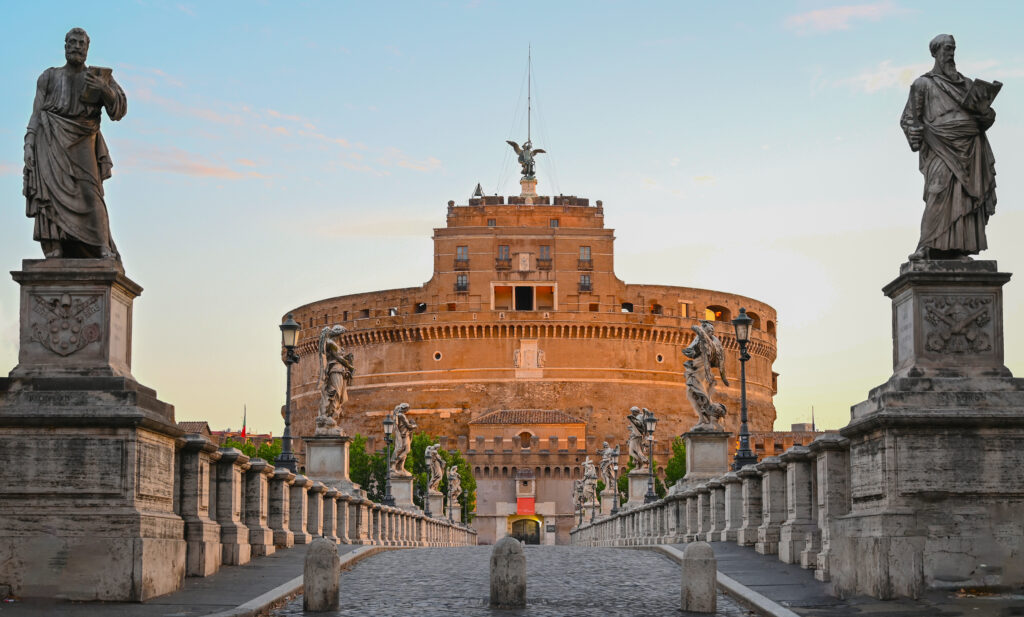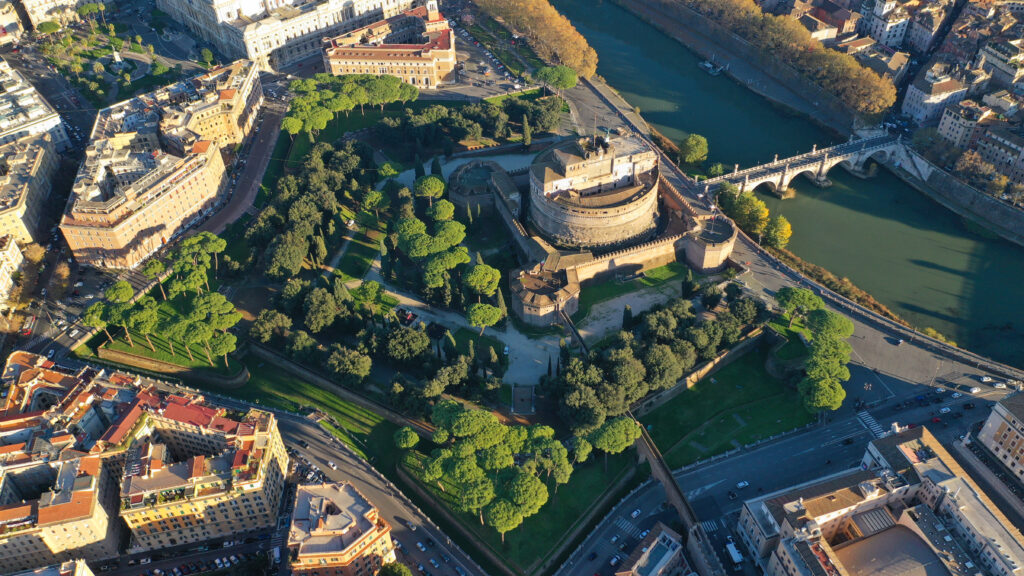Rising majestically on the banks of the Tiber River, just a short walk from both Vatican City and the historic centre of Rome, Castel Sant’Angelo is a monument that embodies nearly two millennia of Italian history. Once the tomb of an emperor, later a fortress, papal residence, prison, and now a national museum—the layers of its past are a story in stone that deserves a close look.

From Emperor’s Tomb to Stronghold
Castel Sant’Angelo began life around 134-139 AD as the Mausoleum of Hadrian, commissioned by Emperor Hadrian as his final resting place and designed to house his ashes and those of his family. Following Hadrian’s death in 138, his remains were placed there, and the mausoleum subsequently held the ashes of several succeeding emperors.
Over the centuries, Rome changed, politics shifted, and the importance of protecting the city grew. By the time of the late Roman Empire, Castel Sant’Angelo was incorporated into the Aurelian Walls (circa 403-409 AD) as part of Rome’s defensive perimeter.
Transformation under the Pope
In the Middle Ages and into the Renaissance, the structure underwent many transformations, adapted to new roles. It became a fortress, a refuge for popes, and was modified to improve defenses. One of its most significant additions was the Passetto di Borgo, a hidden elevated corridor built so popes could escape safely from the Vatican to Castel Sant’Angelo when danger threatened.
During the Sack of Rome in 1527, for example, Pope Clement VII used Castel Sant’Angelo as sanctuary, escaping via the Passetto. Later popes added luxurious apartments, chapels, decorative elements, and fortified bastions—it became both palace and fortress.
The Name and Iconography
The name “Castel Sant’Angelo” comes from a legend tied to Pope Gregory I in 590 AD. During a plague that ravaged Rome, the Pope is said to have had a vision of the Archangel Michael appearing atop the mausoleum, sheathing his sword—a sign that the plague was abating. As a result, the building acquired its present name.
Atop the castle today stands a bronze statue of the Archangel Michael, replacing earlier versions (wood, marble, etc.) over the centuries.
Architecture, Layout & Highlight
Structurally, Castel Sant’Angelo is unique because it merges its original Roman mausoleum architecture with military architecture, Renaissance floor plans, papal apartments, and later defensive modifications.
Some of the key spaces to explore include:
- The original Mausoleum chambers, including the Treasury room that once housed the remains of Roman emperors.
- The Medieval fortifications: ramparts, bastions, defensive walls that show how the castle evolved in response to Rome’s changing threats.
- The papal apartments and ceremonial rooms: vaults and rooms that display Renaissance decoration, frescos, statues, and evidence of papal life.
- The prison cells: Castel Sant’Angelo served as a prison for political prisoners and other detainees. Some of these cells are still visitable.
- The terrace, with panoramic views over the Vatican, Rome, and the Tiber. From here, you can get spectacular perspectives of the city.

Modern Role: Museum & Visitor Experience
Since 1901, Castel Sant’Angelo has operated as the Museo Nazionale di Castel Sant’Angelo. Visitors now can experience each of its historical layers: Roman, medieval, Renaissance, Baroque, and more.
The museum preserves many artifacts, including Roman relics, Medieval defensive features, Renaissance art, and papal memorabilia. There are also special exhibitions from time to time.
When you visit, a few tips are helpful: reserve your ticket in advance (it’s always busy), allow time for climbing to the upper terraces, and wear comfortable shoes because of ramps, stairs, and uneven surfaces. Visiting late in the day can offer quieter moments and beautiful light for photos.
Stories, Myths & Notable Moments
- One of the more dramatic episodes in its history happened in 1527, during the Sack of Rome, when Pope Clement VII rifled through Passetto to escape invading troops. Castel Sant’Angelo’s defensive nature proved vital.
- It also plays a part in culture and literature: Giacomo Puccini chose Castel Sant’Angelo as the setting for the final act of his opera Tosca, where the heroine leaps from the ramparts in despair.
- The structure has been continuously adapted: at times fortress, at times papal palace, at others a prison. Each period left its mark in architectural modifications, decorations, functions.
Why Castel Sant’Angelo Should Be on Your Rome Itinerary
Visiting Castel Sant’Angelo gives you more than just beautiful views or an impressive museum—it offers a cross-section of Roman history. You can trace the journey from Imperial Rome through Christian legend, Papal power, military intrigues, Renaissance art, and more.
For travelers who enjoy architecture, history, or simply walking in historic footsteps, this is a place where so many different stories intersect. As a museum, it balances preservation with accessibility: you get the grandeur without feeling overwhelmed. Pairing the visit with nearby spots—St. Peter’s Basilica, Vatican Museums, or the Ponte Sant’Angelo—is easy and rewarding.

